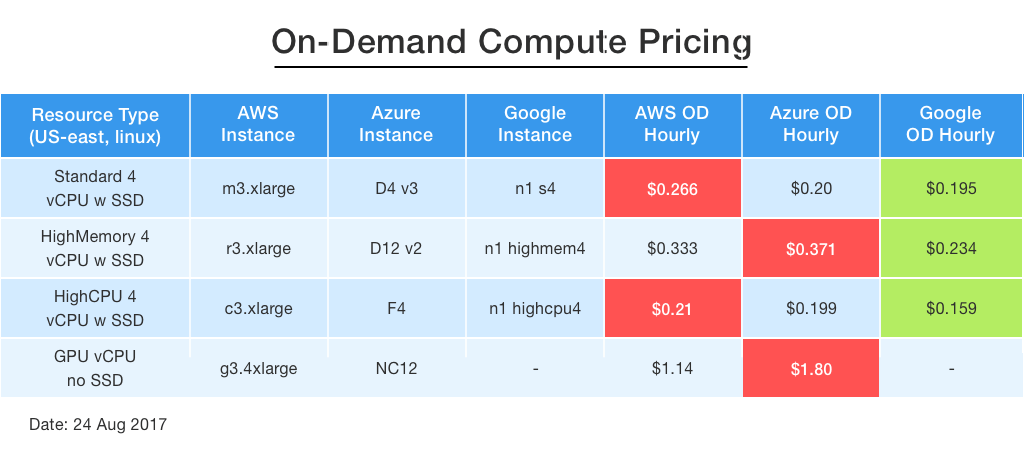On-Demand Compute Pricing: AWS vs. Azure vs. Google
Take note, cloud architects: In this three-way battle of the cloud giants, see how on-demand compute pricing compares among AWS, Azure, and Google.
Join the DZone community and get the full member experience.
Join For FreeComparing cloud compute services is a very difficult task. Because of the diverse deployment options and dissimilar features of different services, formulating relevant and fair comparisons is challenging. This article dives down into the details to show you which providers have the lowest-cost options for cloud compute instances under different circumstances.
The purpose of this post is to show how you can effectively compare the pricing of compute services of the top cloud providers. The instances are the same, but still, by understanding the intricacies of compute pricing, cloud architects can save a lot of money. This analysis also stands as a prerequisite for developing cloud cost optimization strategies. Moreover, knowledge of discounted pricing and reserve instance is beneficial in the long term budgeting of technology funds. In this blog, we’ve compared On Demand Hourly pricing for similar instances from AWS, Azure, and Google.
Compute Pricing
In comparing compute prices, it’s important to note where the compared instances are similar and where they are not. In our analysis, we chose four scenarios to compare instances of AWS, Azure, and Google. All scenarios are based on the lowest price us-east region for each provider and using one of the standard, free Linux options that are available at no extra charge.
Assumptions
For each cloud provider, we then mapped the appropriate instance type for each scenario. You can quickly see that everything cannot be compared exactly “apples-to-apples”. To compare compute price effectively, we’ve chosen similar instances having the same number of vCPUs and RAM for AWS, Azure, and Google. We kept 4 vCPUs as the common link for all three scenarios (Standard, HighMemory, and HighCPU) except GPU instances. For each scenario, we’ve selected instances with a similar amount of RAM to get the lowest pricing instance from AWS, Azure, and Google. For example, in the standard scenario, RAM for instances are 15 (AWS), 16 (Azure), and 15 (Google). This case will the same for other three scenarios as well.
Note: We have used Google Cloud Pricing Calculator to find out Google Compute Engine’s per-hour pricing. To see AWS and Azure pricing, click on AWS On-Demand pricing and Azure Virtual Machines Pricing.

For each of these three instance types, we looked at scenarios where a local SSD is required for better comparison because AWS has instances families with and without the local SSD, while Azure always includes local SSD with all of its instance types, so as a result, you are “paying for it” as part of the instance price whether you need it or not. Google Cloud never includes local SSD with the instance type, so you need to pay for it as an add-on cost. The minimum size for an add-on local SSD is 375 GB, which is quite large.
This comparison will help you to understand which instance has the lowest price for different requirements. We have done all the comparison work in terms of vCPU and memory (RAM) so that you can easily identify lowest pricing instance from main three cloud providers. Here are the scenarios:
Scenarios
- Standard Instance with 4 vCPUs and SSD
- High Memory 4 vCPUs and SSD
- HighCPU with 4 vCPUs and SSD
- GPU with 16 vCPUs and SSD
- Region: US east (Northern Virginia)
AWS vs. Azure vs. Google Cloud: On Demand Compute Pricing Comparison
For each of the four scenarios below, you can see the hourly on-demand (OD) price for each cloud.

Summary and Conclusion
- In the chart above, red indicates the highest price of the cloud providers within a scenario while green represents the lowest price. Google Cloud has the lowest price for all four scenarios.
- For Standard and HighCPU scenarios, AWS has the highest price.
- For HighMemory and GPU, Azure has the highest price.
Published at DZone with permission of Jignesh Solanki. See the original article here.
Opinions expressed by DZone contributors are their own.

Comments